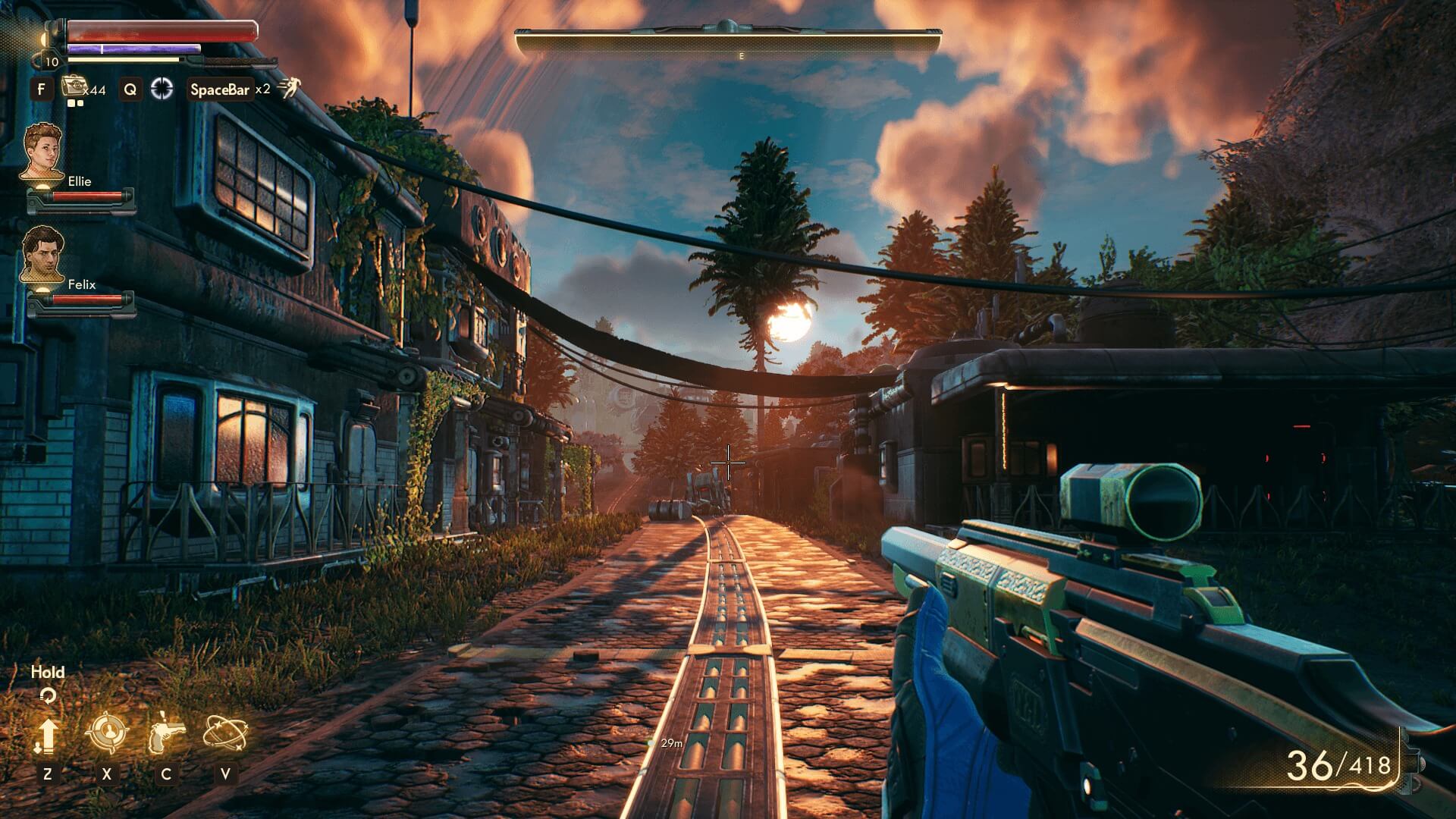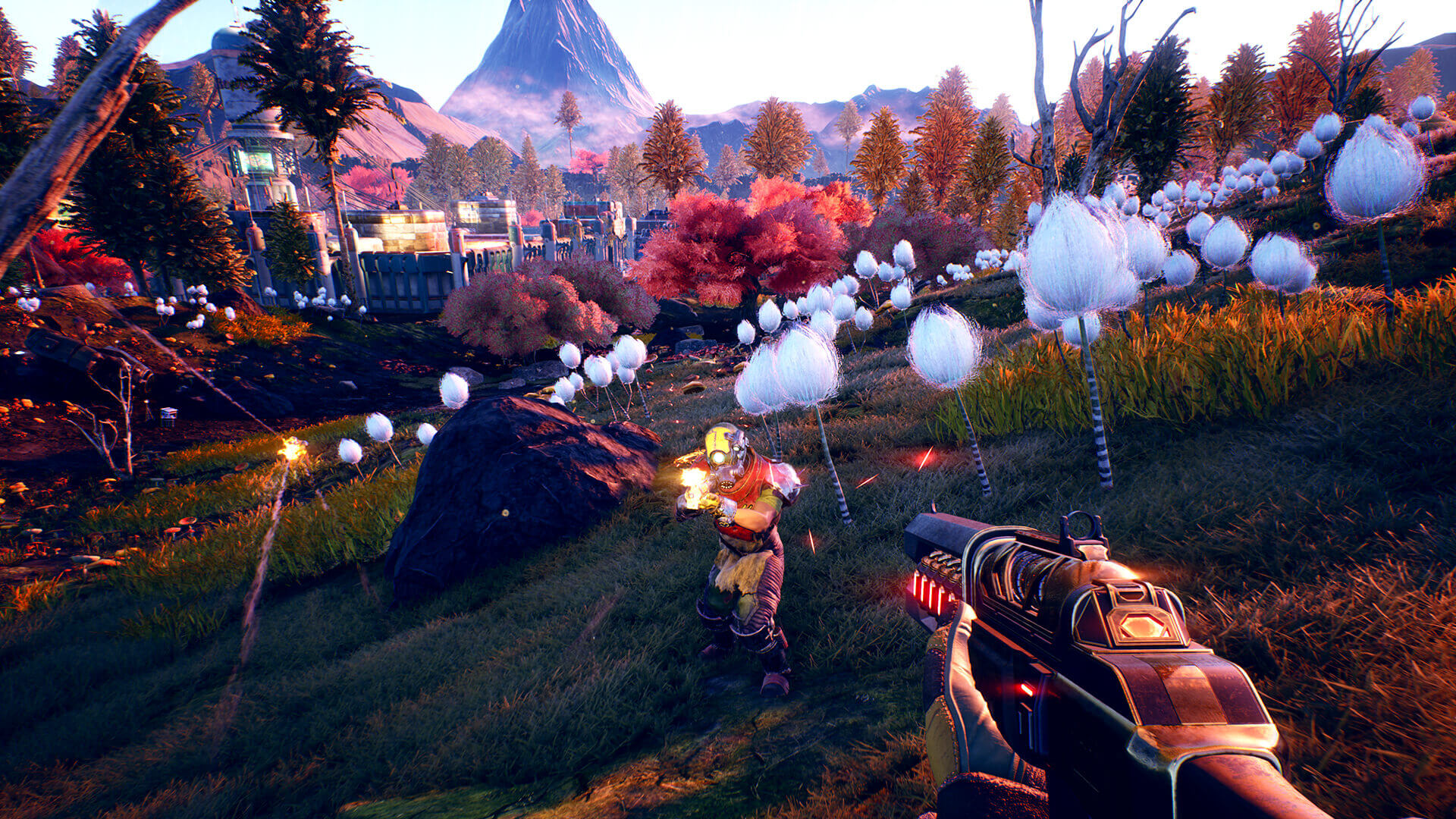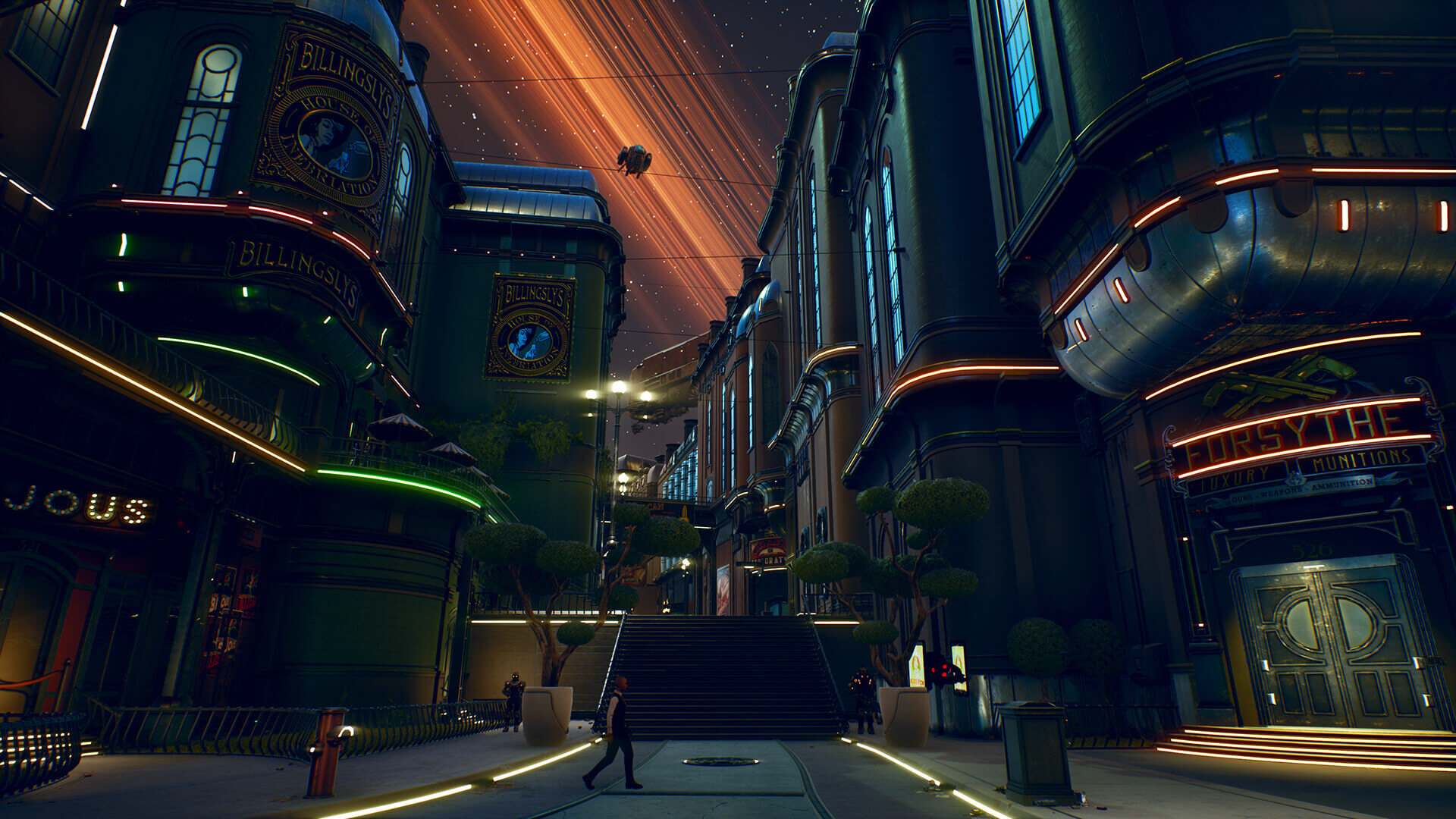The Outer Worlds DEALS
When New Vegas showed up nine years ago, I wasn’t a fan. The parts of the game I could play were great, especially the writing, but I had so many game-breaking bugs that I ultimately gave up. Obsidian didn’t let my disappointment dissuade them and went on to make plenty of other great games I enjoyed. Games like South Park: The Stick of Truth and Pillars of Eternity have been quite popular. The Outer Worlds, however, marks the first time they’ve returned to take on that New Vegas style, and this time I was hoping I’d make it all the way through. Having just finished the game, I think we can call it a victory.

The Fallouter Worlds
It’s easy to draw connections between the design of Outer Worlds and modern Fallout games. It’s not a question whether it was influenced by these games as many qualities make it practically feel like another entry in the franchise. However, the differences are in the details – and that’s what makes the game so appealing.
The most obvious is probably the fact that you can have two companions with you at all times. Your role in the game has you hauling around a small crew of people in a ship – not unlike Mass Effect – and you can roll out with two at a time. Fallout games have had companions before, but here your squad has perks that are leveled in addition to player-chosen gear loadouts. This makes them have more RPG elements than they did in any Fallout game. They even contribute to the building of the story by speaking throughout the dialogue options in ways relevant to their character quite often.
Outer Worlds even has an option reminiscent of the iconic V.A.T.S. system, however here I think it was more enjoyable to use. The “Tactical Time Dilation” slows downtime to extreme levels, but rather than triggering percentage-based shots, you can aim wherever you please on targets. This allows you to take advantage of weak points on enemies and cause massive damage and status effects in a variety of different ways.

Shootin’, Lootin’, Computer Bootin’
The gameplay of Outer Worlds splits itself pretty evenly between you blasting away at people and creatures and walking around talking to NPCs or finding required items. This is reflected in the skill system where you pump points into abilities to make your character better at fighting, talking, or making their way through obstacles. The skill system feels significantly more granular than any Fallout game ever has, and it adds to the number of unique ways you can approach a quest.
Outer Worlds usually offers a brute force way of doing missions and solving problems. A character with exceptional combat skills may not need to talk his way out of anything. The game even allows you to kill nearly anyone and adjusts accordingly. I’m even considering trying a playthrough where I take out anyone in my way just to see if the game can bend that far.
You are, of course, able to resolve many situations with words alone. Using skills like persuade, lie, and intimidate can help you accomplish things faster and often without conflict. It’s even viable to manipulate how you resolve quests using hacking and lockpicking. Sneaking around and finding back ways into areas can be one of the more rewarding ways to make your way through the game, but also one of the more challenging.
While this sort of gameplay isn’t unheard of, the depth to which it is used in Outer Worlds makes the whole experience seem so much more flexible than implementations in other games. Actively deciding what character build you want and then having the game bend to that is rare in my experience. Yet, in this case, the execution is one of the cornerstones of the stellar gameplay.

An Outer World of Pure Imagination
The retro-futuristic look that Fallout was built upon is also present to some degree in The Outer Worlds. The curvy designs of buildings and green-text computer monitors are found throughout the game. However, without the heavy “atomic” influence, Obsidian opted to move away from the ultra-brown environments Fallout presented. They replaced these with beautiful colorful worlds featuring unique flora and fauna.
The alien worlds are almost blindingly vibrant when the sun is high in the sky and seem so alive even being mostly static. While Outer Worlds is split up into some fairly distinct hub areas, several of which are inside, it feels like the sprawling outdoor areas of Terra 2 and Monarch are the places you want to be most of the time. Moving through the halls of an industrial space station or some Firefly-like towns can be enjoyable as well, but the forests and caves of the game are the places where its design shines.

Pay These Writers
The story of Outer Worlds stands out from the very beginning. While the premise of being unfrozen from a lost cryogenic space ship functions as a method to fill in the blank of “you can be anyone,” it also fleshes out the entire narrative. The writers twist and turn around this starting point and have you trying to solve mysteries, figure out who to trust, and making your way full circle by the end.
The best part is, much like Witcher 3, you can find yourself off on side quests that feel even more substantial than the already well-crafted main story thread. You’ll meet so many well-developed characters with backstories that are as deep (or deeper) than the main characters in the game. Even beyond that, the characters of your crew have companion quests that justify their whole personality and interactions with other characters. It makes for moments where they chime in on relevant subjects and have wholly independent conversations with characters you’re speaking to.
These moments are so enjoyable that I made an effort to try and do every single side quest before finishing the game. I’m sure that I missed some, perhaps from just not going to the right place, but exploring the world and its characters was one of the most enjoyable parts of Outer Worlds. I can’t imagine the effort several of the voice actors had to put in recording the numerous lines necessary for all of those interactions and responses.

The Outerstanding Worlds
Finishing this game in around 24 hours of game time felt solid. That may seem low for seasoned RPG players, but I did most of the missions and explored as much of the story as I could. Having a story arc that completes within that time frame feels solid. It doesn’t drag you down as many tangential threads that won’t amount to much, but still gives you room for more than just a sprint to the finish.
Outer Worlds only had a few issues, and they were primarily related to gameplay pacing. The first being that there’s just way too much looting and inventory (weight) management. This is a problem in many RPGs, but here I ended up collecting dozens of types of consumables and I rarely used any at all. Having to clean that up became a chore I hated. Even having a disappointingly limited equipment arrangement for weapons, helmets, and a single armor slot, it seemed like I was buried in junk every 15 minutes.
I suppose it’s not outlandish that Obsidian has once again delivered a high-quality game without much fanfare. The track record they’ve established is one that can’t be ignored. The work they’ve put into The Outer Worlds has created a game that makes Fallout 4 look like it’s backpedaling. Outer Worlds’ story-heavy action and nuanced character development had me diving back in the game with most of my free time. Fans of Elder Scrolls, Fallout, or any dialogue-heavy RPG will probably get a great deal of pleasure stepping into this new universe.
The Review
The Outer Worlds
The Outer Worlds is a spectacular story-heavy RPG with solid FPS and RPG mechanics that only falters in similar areas to other games in this genre. The writing and dialogue stand out above many other games, but much of the other standard RPG elements like character building and combat are also noteworthy.
PROS
- Great writing and enjoyable original story
- Large amount of dialogue and character interactions
- Diverse mission resolution options
- Solid character building choices
- Decent FPS combat
CONS
- The pain of inventory management
- Inconsistent difficulty without changing it manually
The Outer Worlds DEALS
We collect information from many stores for best price available

























































